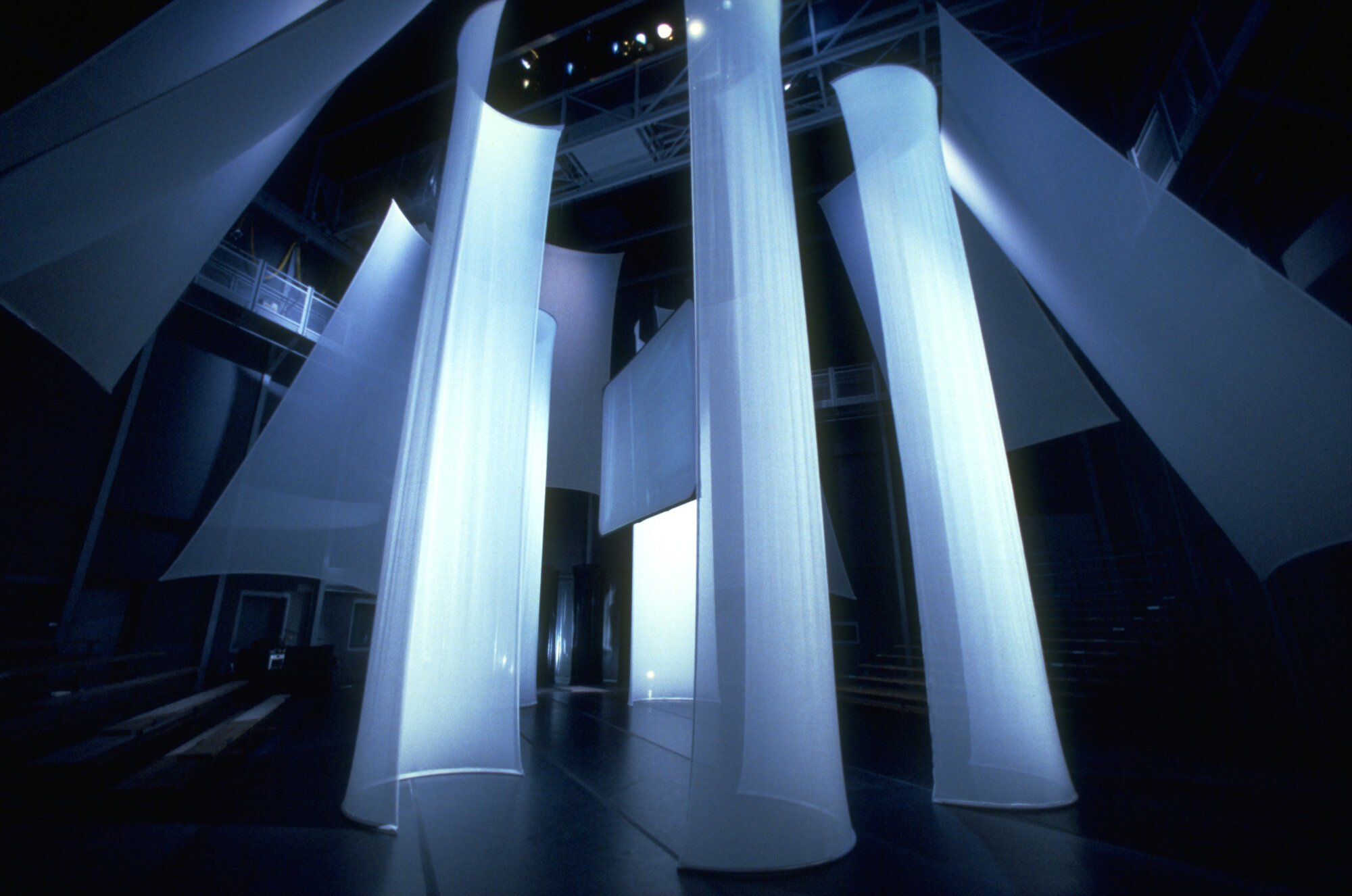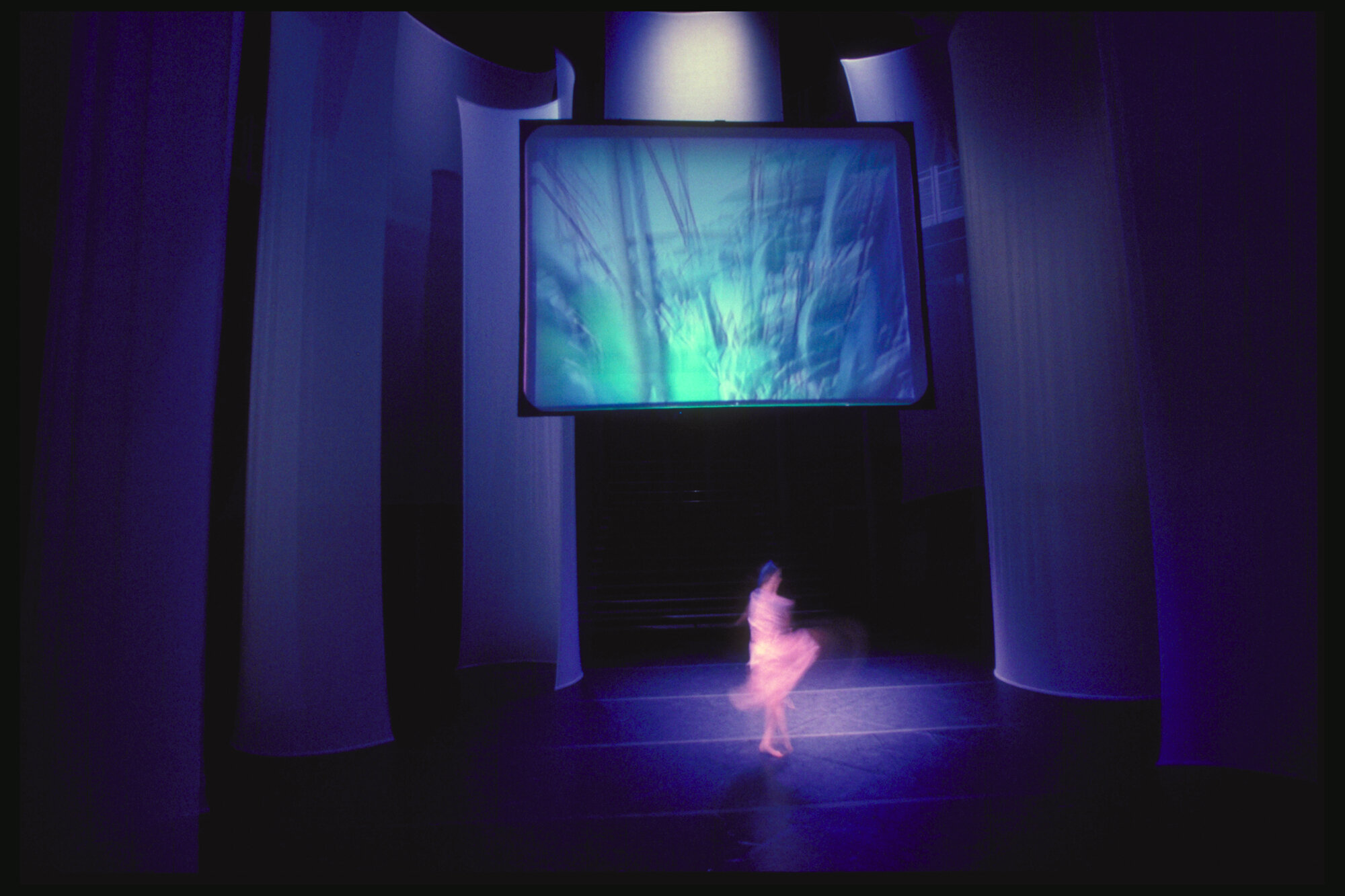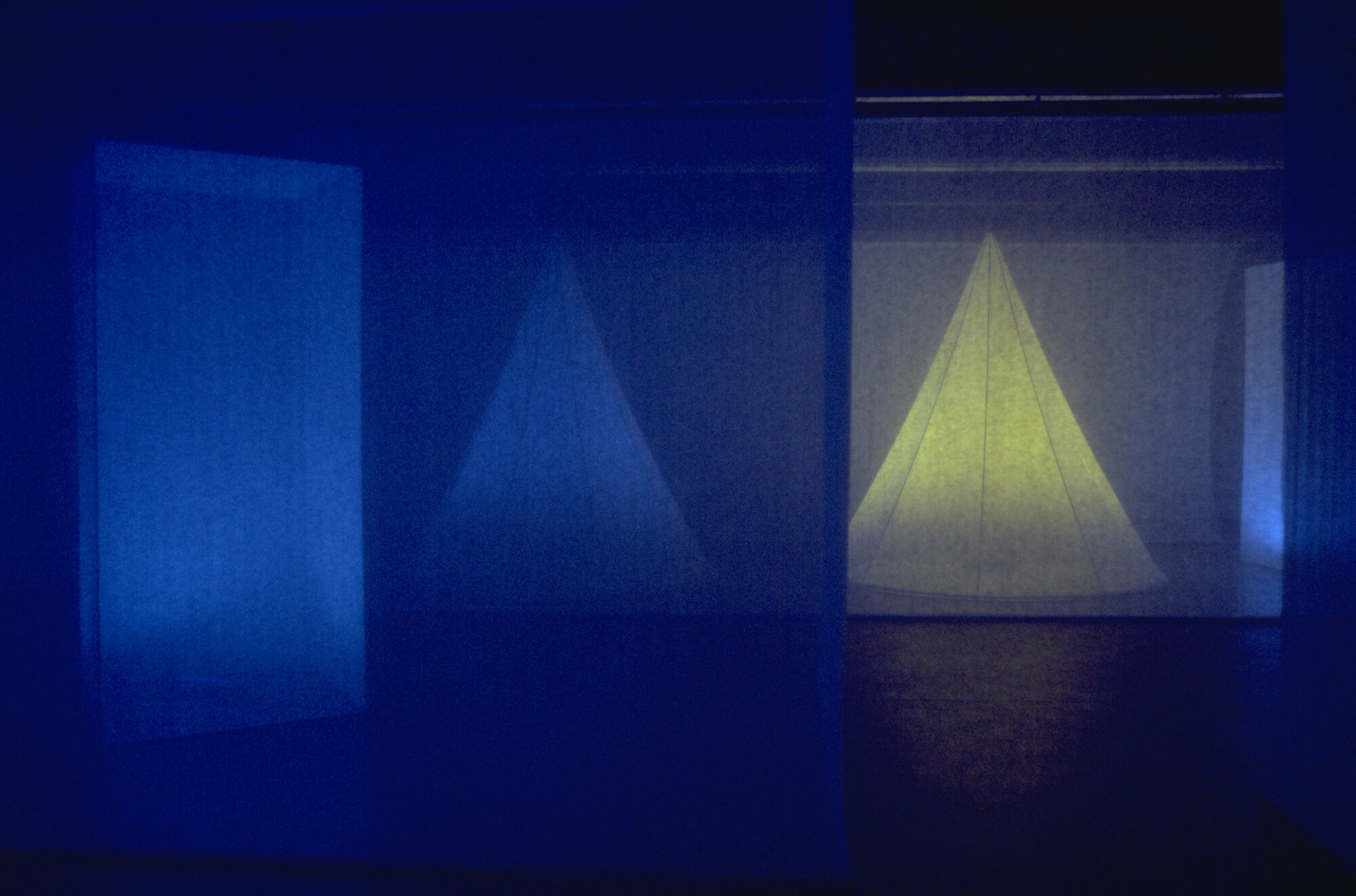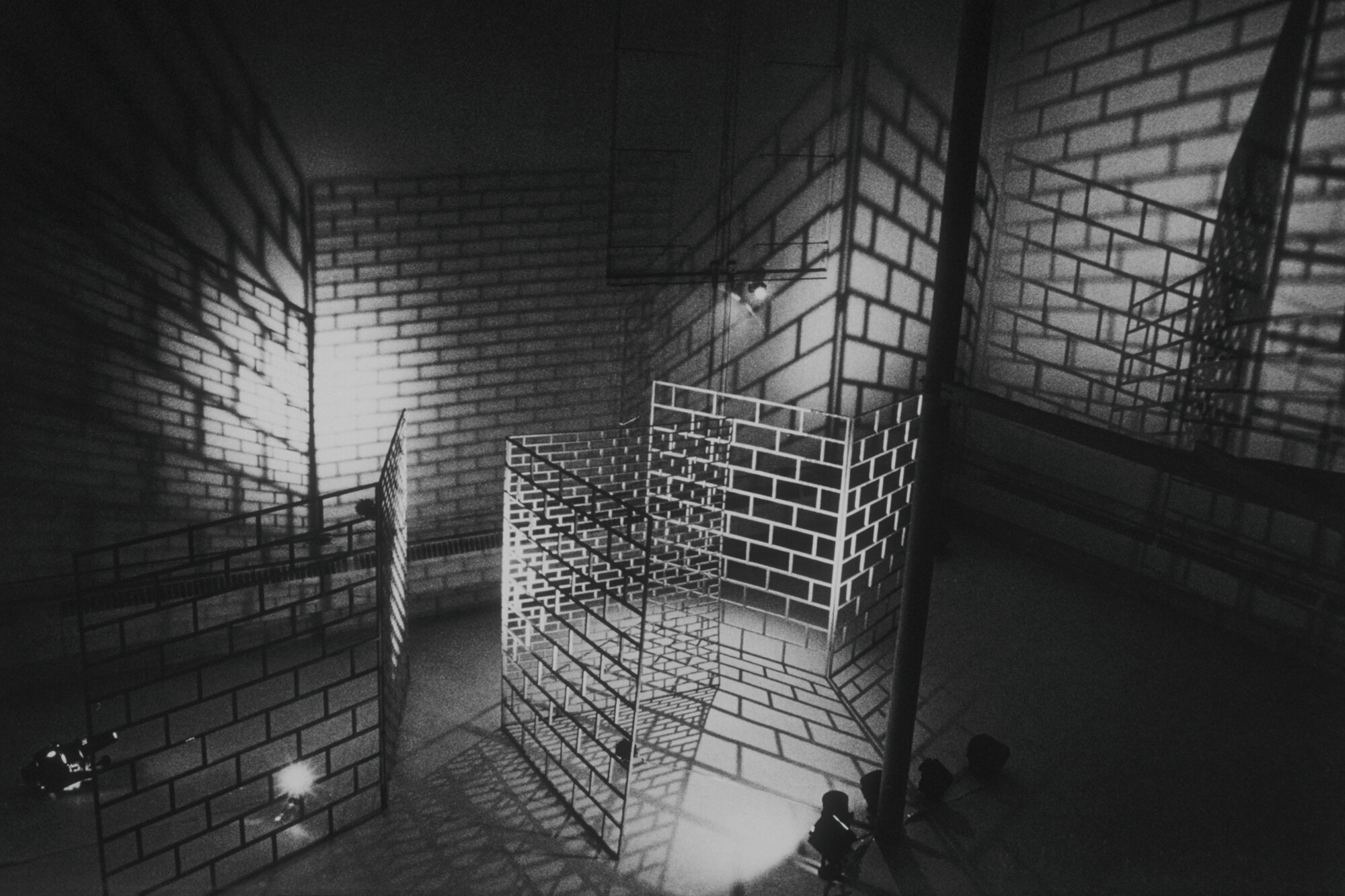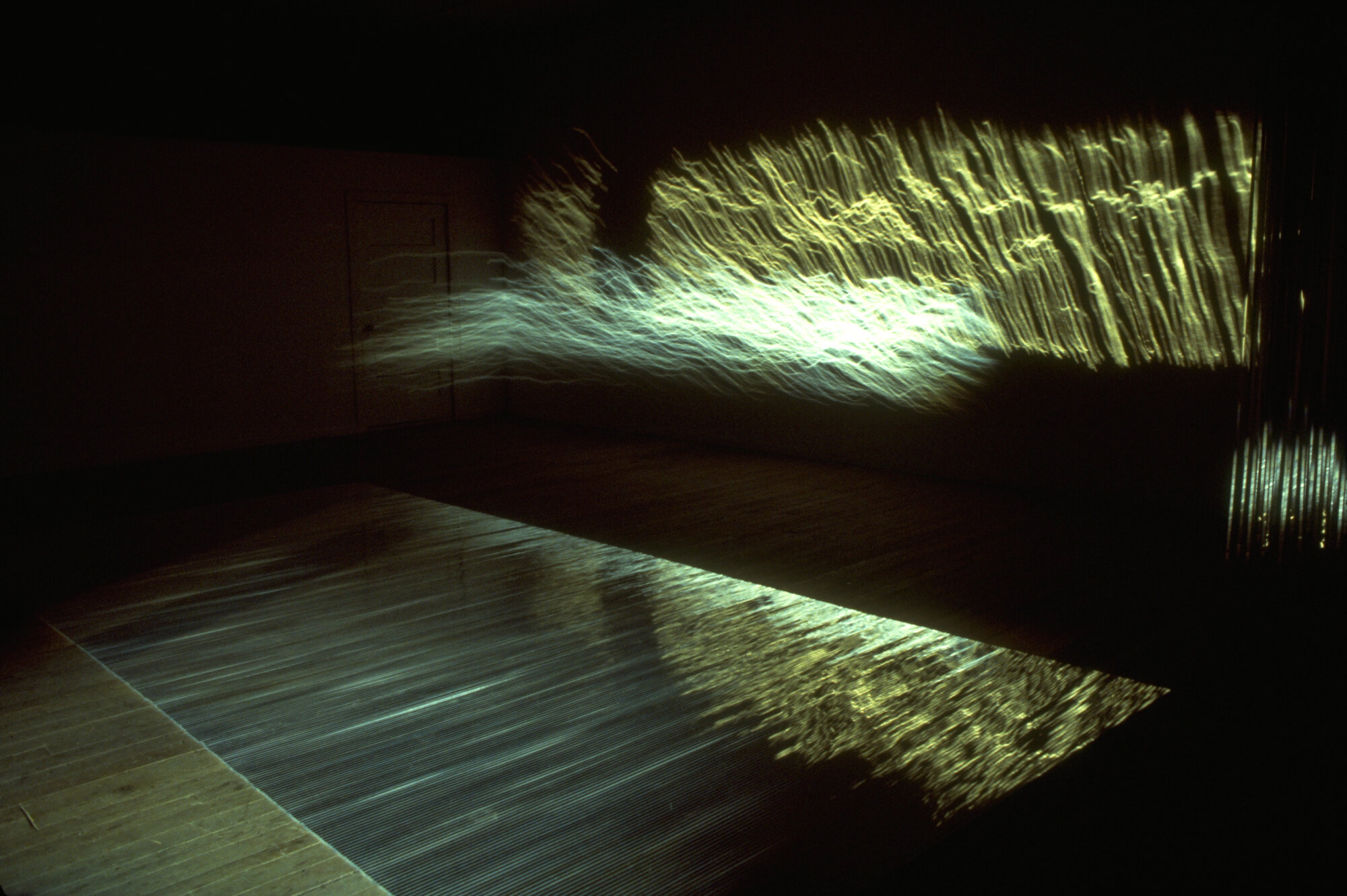
Environments
These light installations were created in the 1980’s while I was a fellow at MIT’s Center for Advanced Visual Studies. Using scrim fabric, aluminum screen, and mirrors, I explored how materials interact with light to create immersive environments. The pieces invite viewers to move through, and often suggest pathways for movement. Some of these installation environments became settings for collaborations with dance and video.
[scroll down for selected works: click-through slide shows; click to enlarge grid images and reviews]
Aviary
1988, MIT Media Lab, Cambridge, MA
Beth Galston (sculptural environment), Ellen Sebring (video and music), with Sarah Skaggs (dance).
Aviary—a one hour performance—creates a mythic, bird-filled fairy tale narrative. The audience is enveloped in the bird environment of the aviary, surrounded by a towering scrim set, spatial music and lighting, and large screen video projections. The set is further animated by a solitary dancer. Aviary was conceived as a performance in “The Cube,” the MIT Media Lab’s unusual four story high “black box” for experimental theater. — adapted and excerpted from the Press Release Read More
Materials: Scrim, steel pipe, cables, plexiglas, hardware, theater lights
Dimensions: 46' 6" H x 61' W x 62' L
Galston's lighting creates a turquoise pool for Skaggs to dive into and a dappled forest for her to explore — Boston Globe
Read Reviews [opens in a new browser window]:
Centerbook | Art New England | Boston Globe | Boston Herald | High Performance | Aviary Program
Geometries
1987, Montserrat College of Art, Beverly, MA
This multilayered environment of floor-to-ceiling scrim fabric panels and geometric forms alternately reveals and obscures itself as viewers move through it. Light-filled shapes emerge, then recede, into the foggy atmosphere. Read More
Materials: Scrim, aluminum pipe, fluorescent lights
Dimensions: 14' H x 48' W x 48' L
Read Reviews [opens in a new browser window]:
Art New England | North Shore Weeklies
Pathways
1990, Massachusetts College of Art, Boston, MA
For this site-specific installation, visitors journey on perforated metal pathways through an environment of suspended screen panels and shadows. Walking through the dimly lit space, they experience a sequence of continually shifting views. Industrial materials and architectural forms soften to almost suggest an outdoor landscape.
Materials: Aluminum screen, aluminum bar, perforated metal, wood
Dimensions: 12' 9" H x 22' W x 44' L
Environmental sculptor Beth Galston's installation "Pathways" at the Massachusetts College of Art's Huntington Gallery brings right-angled geometry into the third dimension. — Boston Globe
Read Reviews [opens in a new browser window]:
Boston Globe | Boston Phoenix
Bound
2000, Emerson Majestic Theater, Boston, MA
Five thirty-foot high scrim fabric columns create a soaring environment for four performers from the Christine Bennett Dance Company. The sculpture shifts in color, mood and translucency in changing theater light. Dancers performing on stilts interact with those on the ground, moving into and around the fabric columns and the pools of light within them.
Materials: Scrim, metal pipe, lights
Dimensions: 30' H x 43' W x 20' L
. . . five 20-foot-high open-faced columns of white gauze . . . mirror the Cyclorama's exposed duct work . . . The columns, designed by Galston, play as large a role in "Bound" as the four dancers do. — Boston Globe
Read Review [opens in a new browser window]:
Boston Globe
Light & Shadow Environment
1994, Artist's studio, Somerville, MA
Light projects through holes in perforated metal columns, casting delicate shadow patterns onto panels of translucent paper. Shadows distort and extend the geometric shapes, creating a dynamic environment of pattern, form and light.
Materials: Vellum, perforated metal, lights
Dimensions: 12' H x 16' W x 16' L
Galston's primary materials are light and shadow and, in the case of the large work currently in her studio, long rolls of white tracing paper and columns of metal perforated with different patterns. — Boston Globe
Read Review [opens in new browser window]:
Boston Globe
Structure / Nonstructure
1989, LeSaffre Wilstein Gallery, Boston, MA
This installation builds an ephemeral structure within the solid architecture of the gallery. Suspended screen panels cast delicate shadows onto the walls. The floor is covered with layers of screen that shift underfoot and create moiré patterns that look like water.
Materials: Aluminum screen, aluminum bar, wire, lights
Dimensions: 8' H x 22' W x 34' L
"Structure/Nonstructure," shown in LeSaffre Wilstein's basement room, was the most object-oriented work yet from this artist, whose scrim set pieces and installations have graced a number of dance and multimedia presentations. — Art in America
Read Review [opens in new browser window]:
Art in America
Appearances / Disappearances
1985, Mobius, Boston, MA
This environment of scrim fabric panels transforms from translucent to opaque according to one’s vantage point in the space. The sculpture is a walk-through installation and a performance, choreographed by Laura Knott, who created a piece for two dancers based on sleep movements. Dancers appear as shadowy figures moving through the layers of scrim. Read More
Materials: Scrim, aluminum pipe, wire, lights
Dimensions: 14' H x 24' W x 42' L
Read Review [opens in new browser window]:
The Tab
Lightwall
1983, Kingston Gallery, Boston, MA
A large mirrored floor panel and a suspended mirrored panel interact with computer-controlled light to project brilliant reflected fields. Wavelike clouds of light are continually transformed by the subtle changes in light emitted by four slide projectors. In a loop of slow dissolves, the reflections evolve in color and intensity, evoking fire, clouds or an icy pond. Read More
Materials: Mirrored plexiglas strips, computer-controlled, projectors, reflections
Dimensions: 12' H x 35' W x 35' L
"Lightwall" is a deceptively simple piece of environmental sculpture that can be transformed by viewer interaction into layers of light that are of dream-like complexity. — Sojourner
Read Reviews [opens in a new browser window]:
Art New England cover | Sojourner | Art New England | Architext | Shaping Space | Equal Times
Grid Environment
1980, MIT Center for Advanced Visual Studies, Cambridge, MA
This environment evolved from a tiny book of paper cutouts that casts shadows as you turn its pages. Each cut page was then enlarged and transformed into a wooden screen. These were installed in a three story white room where they interacted with lights to fill the space with a network of overlapping shadow patterns.
Materials: Wooden screens, spotlights, projectors, dimmer
Dimensions: 25' H x 35' W x 40' L
'Light Images' are formed by the interaction of skeletal and translucent constructions with controlled artificial illumination. They are active environments of light and shadow which change and form multiple configurations. — Leonardo
Read Reviews [opens in a new browser window]:
Leonardo | Rune

